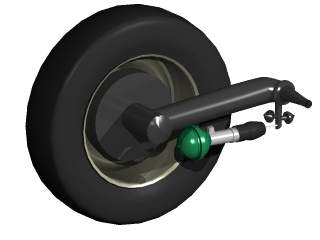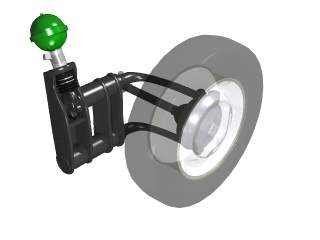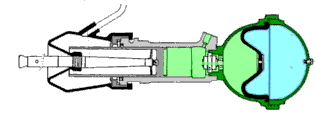Citroën ID/DS Suspension, How does it work
 The picture shows the rear wheel assembly of a ID/DS including the suspension cilinder and sphere. Notice the horizontal design of the suspension. The result is that boot space is not decreased by space needed for the suspension. Notice also that through this design the wheelbase is (slightly) dependant on the heigth of the car.
The picture shows the rear wheel assembly of a ID/DS including the suspension cilinder and sphere. Notice the horizontal design of the suspension. The result is that boot space is not decreased by space needed for the suspension. Notice also that through this design the wheelbase is (slightly) dependant on the heigth of the car.
 The picture on
the left is a graphical representation of the frontwheel assembly with the
suspension cylinder attached. Notice that the break disk is not attached to the wheel. Actually the break disk is attached to the gearbox. This lowers the weight of the moving parts of the wheel assembly A lower weight improves the suspension characteristics. Another interesting fact is the fact that the king pin is located exactly in the center of the wheel. A flat tire, or bump into a hard object, does hardly impact the steering.
The picture on
the left is a graphical representation of the frontwheel assembly with the
suspension cylinder attached. Notice that the break disk is not attached to the wheel. Actually the break disk is attached to the gearbox. This lowers the weight of the moving parts of the wheel assembly A lower weight improves the suspension characteristics. Another interesting fact is the fact that the king pin is located exactly in the center of the wheel. A flat tire, or bump into a hard object, does hardly impact the steering.
 This picture shows
the inside of the rear suspension cylinder while absorbing shocks
introduced during driving. The hydraulic fluid stays in the cylinder during
this process. Only if the height is adjusted, oil is pressed into or released
from, the suspension cylinder. Between the sphere and the cylinder the
shock absorber is visible. The shock absorber reduces the speed of the
hydraulic fluid moving between the two compartments, thus absorbing sudden
movement (shocks).
This picture shows
the inside of the rear suspension cylinder while absorbing shocks
introduced during driving. The hydraulic fluid stays in the cylinder during
this process. Only if the height is adjusted, oil is pressed into or released
from, the suspension cylinder. Between the sphere and the cylinder the
shock absorber is visible. The shock absorber reduces the speed of the
hydraulic fluid moving between the two compartments, thus absorbing sudden
movement (shocks).
- www.schaalbouw.nl/citroen © 2014 E.Paijmans
-

-

-

-

-

-

-

-
